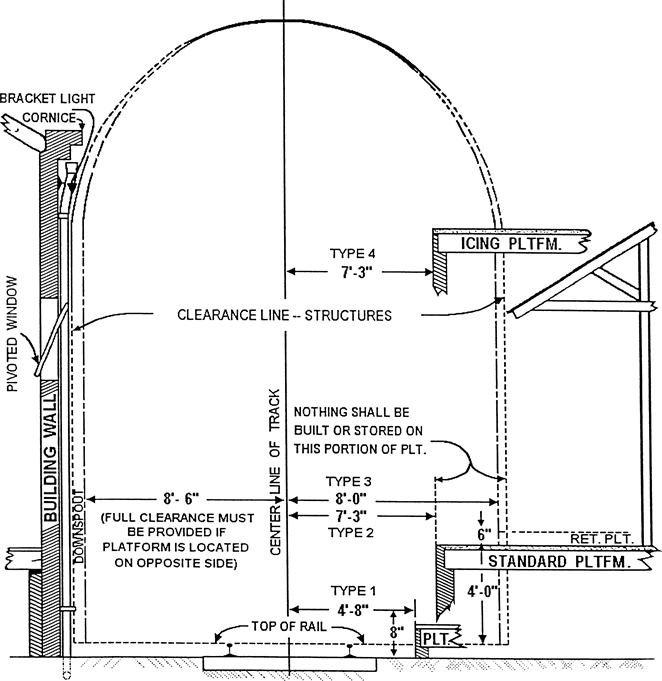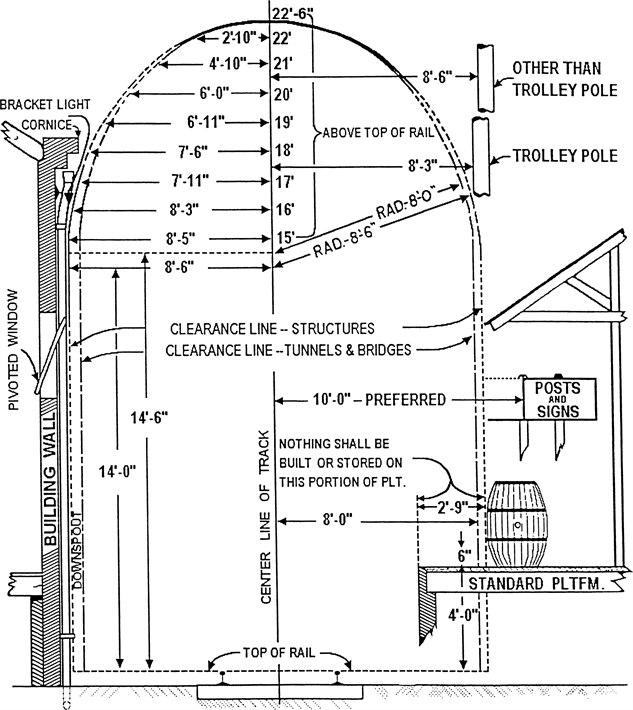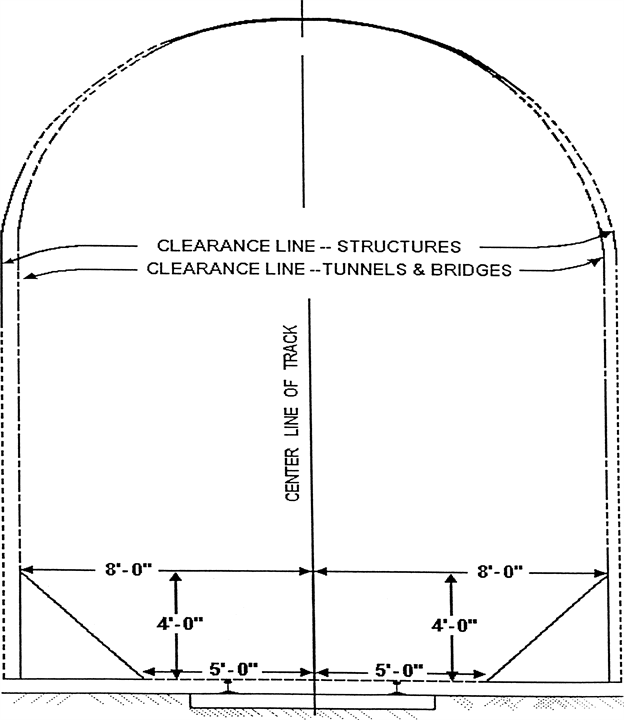You must make sure side clearances are at least eight feet six inches from the track centerline unless clearance requirements found in Tables 2, 3, or 4 apply.
Note: | All side clearances in Tables 2, 3, and 4 that reference "the track centerline" are based on the assumption that private rail operations generally use track that is standard gauge width (4 feet 8 1/2 inches). |
Table 2 - Minimum Side Clearance for Platforms
If Your Platform Type is: | Then the Minimum Clearance Requirements Between the Track Centerline and a Platform Edge are: |
Type 1 | 4 feet 8 inches |
Platforms with heights of 8 inches or less above the top of the rail. | See Illustration 2. |
Type 2 | 7 feet 3 inches |
Platforms with heights of 4 feet or less above the top of the rail. | See Illustration 2. |
Type 3 | 8 feet |
Platforms with heights of 4 feet 6 inches or less above the top of the rail and the platforms are used primarily for loading and/or unloading refrigerator cars. | See Illustration 2. |
Type 4 | 7 feet 3 inches |
Icing platforms and supports. | See Illustration 2. |
Type 5 | |
Retractable platforms attached to permanent structures. | When not in use, use the clearance requirements for a platform of its height. |
Type 6 | |
Platforms that are a combination of Types 1 through 3. (Only Types 1 through 3 platforms can be combined.) | Platforms may be combined if the Type 1 platform has a level surface no more than 4 feet 8 inches from the track centerline to the face of the platform wall with which it is combined. |
Illustration 2 - Minimum Side Clearances for Platforms
 |
EXEMPTION: | Except for handrail and water barrel clearances, the clearance requirements in Table 3 do not apply to bridge decks where railroad employees couple or uncouple cars on a switching lead unless the department approves them. |
Note: | The requirements for filing a variance are located in the Safety and health core rules and chapter 296-900 WAC, Administrative rules. |
Table 3 - Minimum Side Clearances for Bridges, Tunnels and Related Structures
If your side clearance requirement involves: | Then the minimum side clearance requirements between the track centerline and the bridge, tunnel or related structure are: | ||
Bridge and tunnel sides - lower section | 8 feet | ||
Bridge and tunnel sides - upper section | Defined by the half-circumference of a circle whose: | ||
• | Radius is 8 feet; and | ||
• | Center is located on a line perpendicular to the track's centerline and 14 feet 6 inches above the top of the highest rail. | ||
• | See Illustration 3. | ||
Related structures on bridges and in tunnels - lower section structures (or portions of them) that are no more than 4 feet above the top of the rail. For example: | Defined by lines extending: | ||
• | Refuge platforms on bridges and trestles. | • | 5 feet laterally from the track centerline to a point level with the top of the rail and then diagonally upward to another point 4 feet above the top of the rail; and |
• | Water columns, oil columns, and block signals. | • | 8 feet laterally from the track centerline to a point 4 feet above the top of the rail. |
• | Cattle chutes. | • | See Illustration 3A. The shaded portion of the illustration designates the area that must be free of refuge platforms, water columns, oil columns, block signals and cattle chutes. |
Hand rails and water barrels | 7 feet 6 inches | ||
Fences of cattle guards | 6 feet 9 inches | ||
Illustration 3 - Minimum Side Clearances for Bridges, Tunnels and Related structures
 |
Illustration 3A - Minimum Side Clearance for Certain Structures in or on the Lower Sections of Bridges and Tunnels
 |
Note: | 1. The department must approve all minimum clearances for car pulling units and related structures. |
2. The requirements for filing a variance are located in the Safety and health core rules and chapter 296-900 WAC, Administrative rules. |
Table 4 - Other Minimum Side
Clearance Requirements*
If your side clearance requirement involves: | Then the minimum side clearance requirements from the track centerline are: | |
Type A | ||
Engine house and car repair shop doors. | 7 feet 6 inches | |
Type B | ||
Interlocking mechanism, switch boxes, and other similar devices projecting no more than 4 feet above the top of the rail. | 3 feet | |
Type C | ||
Poles supporting trolley contact. | 8 feet 3 inches | |
Type D | ||
Signals and switch stands no more than 3 feet high and located between tracks where it is not possible to allow other clearances required in this chapter. | 6 feet | |
Type E | ||
Signals and switch stands other than those described in Type B and Type D. | 8 feet | |
Type F | ||
Material, merchandise, inventory, storage bins or equipment stacked or stored on ground or platforms adjacent to tracks. | 8 feet 6 inches | |
Note: | ||
This requirement does not apply to: | ||
• | Railroad maintenance operations | |
• | Emergency situations | |
• | Local conditions that make compliance impossible. | |
Type G | ||
Space adjacent to curved track. | Increased to equal tangent track clearances. As a general rule, side clearances on curved track should be increased 1-1/2" for each degree of curvature. | |
* | Table 4 does not have an accompanying illustration. |